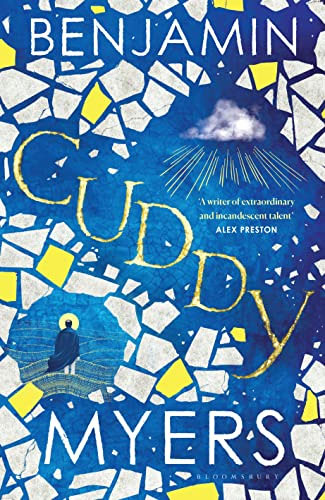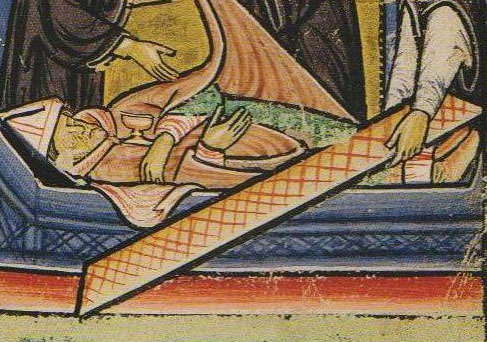
Cuddy, Benjamin Myers (404pp, Bloomsbury)
Like most of Benjamin Myers’ work, Cuddy concerns itself with memory, place, relationships and what might be called mystical presence or psychogeography, that is how the past influences and affects the present or future. In his letter to ‘friends and readers’ which prefaces this review copy, Myers says his book is about ‘human connection’ and that for him ‘writing is a form that borders on the magical’; and also goes on to later declare that ‘just because I don’t have religious faith doesn’t mean I don’t have faith in nature and faith in mankind’. So there!
Why the mention of religious faith? Because Cuddy is hung on the stories that surround Saint Cuthbert and his legacy of Durham Cathedral, shaped as a work in four books plus an interlude and a prologue. This prologue uses broken up prose (I don’t read it as poetry) to ventriloquize Cuddy speaking directly to the reader, an act of paranormal fiction, whilst part one opens with a series of quotes from attributed sources which conjure up the geography and mood of North East England, before we are introduced to the group of monks and their servants and hangers-on who are carrying the coffin of their Saint to keep it away from the Viking raiders.
There are visions and signs, info drops, historical scene setting and much incantation and breast-beating before the group arrive at what will become Durham and declare that they will build a great church on this looped bend in the river to house Cuddy. In the final part of Book I we are told ‘The first stone was laid late last August’ and that ‘[t]his is England anew’.
Book II’s ‘England anew’ turns out to be AD 1346 and the late medieval squalor of a town spreading around a cathedral that is still being built. It is a love story but also one of hate, surrounded by lechery and prostitution, sexism and patriarchy. The bullying, violent Fletcher Bullard is away on military duty, and his wife slowly gets to know and then learn to love, the stonemason Francis Rolfe. Meanwhile there are monks secretly bonking in the woods, abusing boys and each other, and revengeful plots and accidents being hatched, until Fletcher Bullard, back from the front, has to run. Eda Bullard, our narrator, seems self-aware, and at times speaks directly to the reader:
‘My story and that of Fletcher Ballard, just one story in a
thousand million stories that combine to define a place’
and, later on
‘The stories we tell one another are all that shall remain when
time dies and even the strongest sculpted stones crumble to
sand.’
It is this ‘sculpted stone’ that speaks in the brief ‘Interlude’, offering a voiceover commentary on what happens in a brief, ten page script focussing on the imprisonment of 3,000 Scottish soldiers in the cathedral by Oliver Cromwell:
‘Bones become dust. Dust gathers. A spirit
settles and these brave young lads become ghosts of this
uncivil war, left to stalk the ancient city that stole them.
Yet here remains immoveable, watching. Stone of God,
God of stone. The whole of hell. Sufferance in its totality.
I remember the names of my new sons. I hold them all
in my architecture for evermore, for no one else will.
And then we are in 1827 for Book III, where Saint Cuthbert is being exhumed. Professor Forbes Fawcett-Black is our rather refined and self-impressed narrator. He does not like being summoned to the North, does not agree with digging up the body, nor like the fact the is subject to aural hallucinations:
‘o Cuddy Cuddy o
o Lord o God
o Jesus
The very sound of this whispered mantra, so dire in its deliv-
ery, made me want to flee from the room, but I could not move
for I was frozen stiff with fear.’
And perhaps rightly so. Despite repeated warnings in his mind to ‘Let. History. Lie‘ (later reimagined as ‘Let his story lie’) Cuthbert’s carved and inscribed coffin is raised up and desecrated:
‘Time-crumbled wood and soil-soured bones and the damp
rot of death-earth; all was a mess in this hallowed stone place’
The speaker of the mantra is revealed to be an owl-faced boy we have previously met, who continues to haunt Fawcett-Black, as do others from Cuddy’s past: ‘in dreams and waking nightmares I hear the chanting of the saint’s tortured acolytes’. Despite his complicity, the Professor refuses to engage with or reveal what happened next:
‘I know not what became of the remains of the Saint Cuthbert.
And I shall neither write nor speak of the matter again.’
So he shuts his notebook, unaware that our future eyes will read his journal, unaware that he is one strand of Myers’ fiction woven around Cuddy.
Myers tells us he ‘grew up close to Durham Cathedral […]which has always been something of a personal obsession’, and this may have helped inform the more naturalist and contemporary Book IV, which is set in 2019. Here, Michael is struggling to keep both his dying mother and himself warm and fed, travelling miles, often on foot, to casual labouring jobs, courtesy of an agency which pockets a large percentage of his take home pay. He is a grafter, though, and gets noticed by a foreman who eventually directs him to Durham Cathedral to work for a colleague. Nearer to home, working alongside a team of masons and archaeologists who do not abuse, ignore or bully him, Michael comes under the spell of the cathedral as well as Evie, a female student working in the cafe where he collects the lunches to deliver up the tower. Although no love affair with Evie ensues, and Michael and his mother both gently exit the book on the final page, it is an exquisite study in ‘human connection’ across time, class divides and generations.
As indeed the whole book is. Since Myers himself uses the word ‘magic’, I don’t mind saying this is a brutal, enchanted, magical fiction, working on so many levels and in so many genres. Cuddy is folk story, history, romantic fiction, historical fiction, creative non-fiction, truth, memory and lie. Perhaps Michael says it best, as he talks to Saint Cuthbert (or himself), so I’ll leave the end of this review to him:
‘Do you believe in me?
I believe there was once a man called Cuthbert who they
reckon tended sheep as a boy, and became a monk who lived on
a rock, and his body was sometimes kept in a cave and then, when
the Vikings came, carried all about the place. And then, later,
when the folk who carried him got tired or saw a cow and
received a sign, depending on what you believe, they built first
a church to house his body, then a bigger church and then the
cathedral, and Durham was born. And there his bones lie today,
sealed beneath stone, where Japanese tourists kneel and the cafe
sells scones the size of your fist. And he is you.
But what do you believe, Michael?
I don’t know.
It’s OK not to know. Only the arrogant and the ignorant are certain.
Everything else is myth and mystery. Untold history.‘

Rupert Loydell
